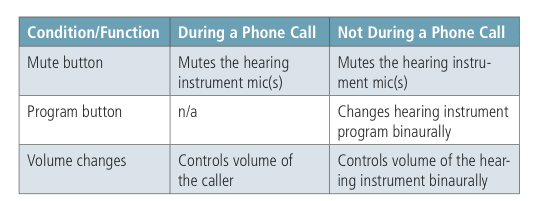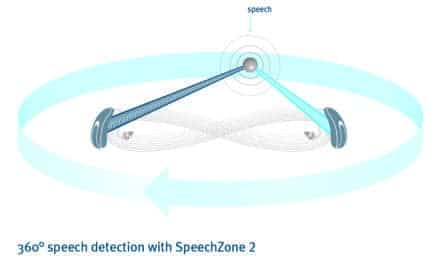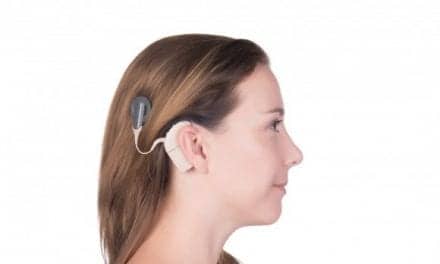Finding the appropriate phone option for individual users has become critical in dispensing
hearing instruments.
By Jenny Nesgaard Pedersen, AuD
The phone is used globally as a means of communication. The level of need for phone use, the environment in which the person uses the phone, and the types of phone are variable.1 However, almost everyone relies to some degree on adequate phone use, and this is a common need for a majority of the world population.
An inability to communicate on the phone has been linked at a statistically significant level to a perceived reduction in the quality of life among individuals with hearing loss.2 Recent reports indicate that phone solutions with contemporary hearing instruments reduce the level of experienced hearing handicap by about 60%.3
Despite the potential impact on quality of life that successful phone use can provide, many hearing instrument users still fail to perform at a satisfactory level on the phone,4 and failure to use hearing instruments with the phone is reported as one of the main reasons why the owners of hearing instruments do not use them.5
There are several factors that contribute to experienced difficulties communicating on the phone. These include the absence of visual cues, inappropriate or inadequate methods of using the phone with hearing instruments, and the presence of background noise.6,7
Some hearing instrument users opt to remove the hearing instrument when using the phone, due to a lack of perceived benefit or a reduction in perceived speech understanding when using hearing instruments on the phone. This is problematic, as phone use may be one of the main reasons why people with hearing loss initially pursue amplification. Finding the right phone solution for every end user is therefore central to successful hearing instrument use. For this reason, ReSound strives to offer phone solutions with hearing instruments and accessories to fit the needs of nearly every individual.
A Menu of Phone Options
All technology to connect hearing instruments to mobile phones and landline phones has one major functional goal: to improve the signal-to-noise ratio (SNR), thereby making speech easier to hear in the presence of background noise. The phone can be used directly with the hearing instruments by holding the receiver to the ear. Other methods of using the phone with hearing instruments include the use of inductive telecoil technology and digital wireless signal routing.
Traditional Phone Use with Hearing Instruments
Although it is possible and natural to hold the phone next to the hearing instrument, there is a significant risk of feedback if the gains are set relatively high and/or if the fitting is open.1 Feedback occurs most often when the phone receiver is held in proximity to the hearing instrument.

|
| Figure 1. An example of a Bluetooth-enabled cellphone, the ReSound Phone Clip+ control, and a Verso hearing aid. |
Fortunately, the last decade has seen the development of feedback management algorithms aimed at significantly reducing feedback. For example, ReSound Verso offers DFS Ultra II, a feature designed to control feedback even in extremely dynamic situations, such as when a phone is held near the hearing instrument during a typical phone conversation. Overall gain is preserved while only the feedback is eliminated. The feature models both the feedback path and the input signal, which improves its accuracy in identifying true feedback from other tonal input sounds. Recent improvements in precision and scaling result in a higher degree of accuracy in cancelling feedback than was previously possible. In sum, DFS Ultra II offers increased stable gain and combats feedback in the most difficult situations, while preserving overall sound quality.
The phone solutions that have been discussed so far present the phone signal monaurally. This is the natural mode of using the phone, employed by unaided listeners as well. The alternative to monaural listening is binaural listening. Binaural listening affords several benefits, including improved speech recognition. The following section discusses digital wireless streaming in combination with phone use and the binaural listening advantages offered by this technology.
Digital Wireless Streaming
ReSound Unite wireless technology provides a robust wireless connection, made possible through the ReSound RangeTM II integrated chip and the use of proprietary 2.4 GHz wireless technology. This technology enables the transmission of the signal over longer distances—at least 7 meters (7+ yards). Proprietary 2.4 GHz technology limits interference from other devices and allows for a smaller antenna to be integrated into the hearing instrument.

|
| Figure 2. The ReSound Unite Phone Clip+ control receives Bluetooth transmissions from a cellphone and then transmits the phone signals to the hearing aids binaurally using 2.4 GHz proprietary wireless technology. |
One of the main benefits of wireless signal routing is the simultaneous delivery of the signal to both ears (Figure 2). Several lines of evidence suggest that listening with two ears generally results in better results than listening monaurally.6,9,10 Binaural hearing instrument use improves speech perception both in quiet and in noise, and also improves horizontal localization abilities.10-12
In a recent study, Picou and Ricketts6 observed significant benefit when speech was transmitted bilaterally in the presence of several different noise configurations. This benefit was attributed to binaural summation (or binaural redundancy), and binaural squelch. However, the drawback to binaural listening to a streamed signal, such as the phone conversation, is the loss of environmental sound awareness. This is especially true if no microphone input is selected along with the streamed signal.
The new Unite Phone Clip+ is a small wireless accessory that links a Bluetooth-enabled mobile or landline phone to the hearing instruments. As a small device, it can be affixed to the clothing. The phone signal alone can be transmitted to both ears simultaneously, resulting in improved speech intelligibility in both quiet and noisy surroundings. It is possible to add hearing instrument microphone input to the streamed signal, and the amount of microphone versus streamed signal can be adjusted through the microphone-streaming balance in the Aventa fitting software and via the Unite Remote Control. The sound received in the hearing instruments for the streamed and/or microphone input is amplified as programmed for the individual user, accounting for the specific frequency response needed for the individual’s hearing loss.
In addition to streaming sound from the phone directly to the hearing instruments, the Phone Clip+ offers other functionality. This functionality applies regardless of whether the user is on the phone. Conveniently located on the front of the Phone Clip+, there is a mute button (“M”) and a program button (“P”). Volume adjustments can be made through the “+/-” buttons on the side of the device. Table 1 shows the functionality of these controls when the user is both using and not using the phone.

|
| Table 1. Operation of the Phone Clip+ controls during and outside of a phone call. (click to enlarge) |
An on/off switch is included on the side of the Phone Clip+. Separate LED lights indicate the operational status. Directional microphones are integrated in the device, and covered with a wind screen to reduce wind noise when using the Phone Clip+ outdoors. A new swivel-clip is also included, to optimize the directional response of the microphones and to facilitate attaching to the user’s clothing.
Conclusions
The need to communicate on the phone is universal. In many instances, the desire for better listening abilities on the phone is the driving force behind people with hearing loss deciding to pursue amplification. Lacking success in this area can often lead to a decreased use of hearing instruments overall. It is therefore crucial that the clinician identifies the best phone solution for the needs of the individual hearing instrument user.
ReSound offers a new digital wireless technology that takes advantage of binaural listening benefits, such as improved speech intelligibility. For hearing instrument users who desire a more natural phone experience along with environmental awareness, the Comfort Phone enhancement of the PhoneNow feature may be optimal.

|
Jenny Nesgaard Pedersen, AuD, is an audiologist at GN ReSound in Ballerup, Denmark. Correspondence can be addressed to Dr Pedersen at: [email protected]
|
References
1. Palmer C. Ring, ring! Is anybody there? Telephone solutions for hearing aid users. Hear Jour. 2001;54(9):10-18.
2. Dalton DS, Cruickshanks KJ, Klein BE, et al. The impact of hearing loss on quality of life in older adults. Gerontologist. 2003;43(5):661-668.
3. Kochkin S. MarkeTrak VIII: Patients report improved quality of life with hearing aid usage. Hear Jour. 2011;64(6):25-32.
4. Desjardins JL, Doherty KA. Do experienced hearing aid users know how to use their hearing aids correctly? Am J Audiol. 2009;18(1):69-76.
5. Kochkin S. MarkeTrak V: “Why my hearing aids are in the drawer”: the consumers’ perspective. Hear Jour. 2000;53(2):34-41.
6. Picou EM, Ricketts TA. Comparison of wireless and acoustic hearing aid-based telephone listening strategies. Ear Hear. 2011;32(2):209-220.
7. Mackersie CL, Qi Y, Boothroyd A, et al. Evaluation of cellular phone technology with digital hearing aid features: effects of encoding and individualized amplification. J Am Acad Audiol. 2009;20(2):109-118.
8. Goldberg H. Telephone amplifying pick-up devices. Hearing Instruments. 1975;26:19-20.
9. Kochkin S, Kuk F. The binaural advantage: evidence from subjective benefit and customer satisfaction. Hearing Review. 1997;4(4):29-34.
10. Boymans M, Govents ST, et al. A prospective multi-centre study of the benefits of bilateral hearing aids. Ear Hear. 2008;29(6):930-41.
11. Hawkins DB, Yacullo WS. Signal-to-noise ratio advantage of binaural hearing aids and directional microphones under different levels of reverberation. J Speech Hear Disord. 1984;49(3):278-286.
12. Kobler S, Rosenhall U. Horizontal localization and speech intelligibility with bilateral and unilateral hearing aid amplification. Int J Audiol. 2002;41(7):395-400.





